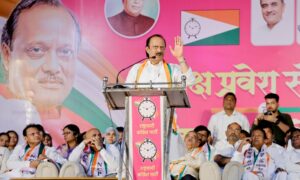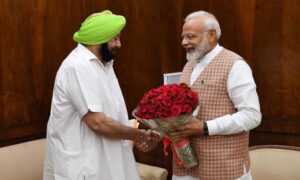
File Picture Courtesy : Financial Express
The implications of landslide victory of the BJP in Tripura election and rejection of the CPM by a mixed electorate of the Bengali and the tribes are far reaching and certain to influence the politics of South West Assam, Manipur and even West Bengal. What really influenced the minds of the Bengali hindu voters is a question that we must address. The non tribal Hindu population of Tripura consists almost entirely of people of East Bengal origin and from the neighbouring districts of Comilla and Sylhet in Bangladesh and Barak valley districts of Assam. One must remember that Tripura is not a natural part of the North East as it became so only after Partition and its transport and logistics have been entirely linked to Bengal.
The Maharaja was a great patron of the Bengali language and culture and Bengali was the official language and all court proceedings and judgements were delivered in Bengali from the early 20th century. Interestingly, appeals against the orders preferred before the Privy council in England were also disposed of in in Bengali – a fact that should come as surprise to the present generation.
This explains partly the presence of the Bengalis in Tripura. Further, the Maharaja owned vast zamindari estates in Bengal- Chakla – Roshanabad in Sylhet for instance income from which was Tripura’s main source of wealth and enabled the princely family to gain high standing among other princes. The displaced Hindus from East Pakistan thus were welcomed in the sparsely populated Tripura and soon they outnumbered the native Tripura Tribes who were also Hindus and shared the same culture ; and this facilitated settlement of the Bengali Refugees who entered Tripura following mass migration after partition and well after the liberation of Bangladesh.
Over the years a composite culture with strong Bengali overtones emerged in Tripura which produced great artists like Sachin Dev Burman and Rahul Dev Burman; and the Communist party had tribal leaders like Dasharath Deb who along with Nripen Chakravarti led the tribal struggle for land rights in pre 1947 Rule of the Maharaja.A shared culture and common revolutionary heritage created the left base in Tripura and the fact, that the Communist movement grew up in the 1930’s from among the ranks of the “Yugantar and Anushilan Samiti,” the two great streams of the revolutionary movement for freedom in Bengal earned for the Communist movement its credentials.
The long spells of CPM rule had roots in this history a And one must note that the bold decisions the Government led by the CPM in Tripura and Congress in the center took following Tripura Accord with the Tripura Tribal National volunteers, the insurgent force in 1988 to extend autonomy under the 6th schedule of the Constitution to the Tripura Tribal Areas paved the way for peace and Reconciliation in Tripura.
This was followed by sustained efforts to restructure the Tribal economy by successful spread of rubber and fruit processing industry and infrastructure development. The withdrawal of the Armed forces Special Powers Act from Tripura in 2017 signalled the end of tribal insurgency in Tripura which was indeed an achievement of the CPM government. And yet the CPM lost heavily for several strong reasons.
First, though it restored peace, its development agenda failed to match the aspirations of the Youth of the post Soviet generation longing for fast progress in modern sectors like information technology and services which the government not only failed to deliver but also seen even unresponsive to interest shown by the private corporate Sector due to its to a backdated, failed left ideology.
The people of Tripura therefore concluded that ” below poverty line” oriented development could take the state upto a certain level but not to the high way to rapid growth. Hence, the personal honesty of the Chief Minister was discounted in preference to BJP growth agenda that promised expansion of the opportunity for fulfilling ” middle class aspirations” of the Youth.
Second, the Tribal violence in the 1980s.created a lasting sense of insecurity among the Bengalis in tribal area who sensing that the tribals are going to vote for the BJP even when the tribals knew that the BJP’s support to the Tribal demand for a separate state was notional opted for a practical decision to go with the tribals and vote for the BJP.
Third, the development in Assam following the National Register of citizens update exercise which has reached Its final stage now has heightened the sense of insecurity among the Bengali Hindu population in the whole of the North East Region about its possible fall out – not withstanding the commitment of the BJP not to deport Hindu migrants from Bangladesh.
A vote for BJP by the Bengali Hindu population of Tripura made good practical sense in this situation and exercise of this what Rousseau called ” general will” has resulted in the first ever BJP government in a Bengali Hindu majority state and a first ever Bengali BJP chief Minister.
No doubt this is a historic development which will influence not only developments in Assam and North East but also in West Bengal. It has unnerved Congress in Assam as it could no longer take Bengali Hindu votes for granted. The unprecedented success of the BJP – the successor of Jan Sangh party Dr. Syama Prasad Mukherjee founded and the following the BJP secured among the Bengalis might as well change the course of politics in Assam and North East.


















